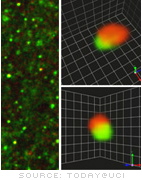Searching for the "Engram" and Finding It at UC-Irvine
Following upon the work of Ramon y Cajal and Sherrington, the Canadian neuropsychologist, Donald O. Hebb (1904-1985), disagreed with Lashley and argued for a mechanism by which memories could be localized, i.e., his proposal for the "Hebbian synapse" on the neuron and collections of such synapses across associated neurons in the form of "cell assemblies" (see Brown & Milner, 2003, for a longer appreciation of Hebb's contributions). For the past four decades, the focus for identifying Hebbian synapses has been undertaken under the overarching research concern for long-term potentiation (LPT), that is, the assumption that "information is storied in the brain as changes in synaptic efficiency..." and that "the location of storage, the engram of learning and memory, must therefore be found among those synapses which support activity-dependent changes in synaptic efficiency" (Bliss & Collingridge, 1993, p. 31).

So, more than a century after Semon proposed a role for a physical trace in the brain's cell in the establishment of a memory, laboratory research has appeared to confirm this finding.the study shows that synaptic connections in a region of rats' brains critical to learning change shape when the rodents learn to navigate a new, complex environment. In turn, when drugs are administered that block these changes, the rats don’t learn, confirming the essential role the shape change plays in the production of stable memory...Working with advanced microscopic techniques called restorative deconvolution microscopy, the UC Irvine team found that the LTP-related markers appear during learning and are associated with expanded synapses in the hippocampus. Because the size of a synapse relates to its effectiveness in transmitting messages between neurons, the new results indicate that learning improves communication between particular groups of brain cells. (UC Irvine scientists, 2007, July 25).
Target article: Fedulov, V., Rex, C. S., Simmons, D. A., Palmer, L., Gall, C. M., & Lynch, G. (2007). Evidence that long-term potentiation occurs within individual hippocampal synapses during learning. Journal of Neuroscience, 27(30), 8031-8039. [Link to abstract]
Press release: UC Irvine scientists unveil the 'face' of a new memory [Press release]. (2007, July 24). Today@UCI. Retrieved July 31, 2007 from the UCI website: http://today.uci.edu/news/release_detail.asp?key=1638
References
Bliss, T. V. P., & Collingridge, G. L. (1993, Jan 7). A synaptic model of memory: Long-term potentiation in the hippocampus. Nature, 361(6407), 31-39.
Brown, R. E., & Milner, P. M. (2003). The legacy of Donald O. Hebb: More than the Hebb synapse. Nature Reviews Neuroscience, 4, 1013-1019. Retrieved July 31, 2007 from http://www.nature.com/nrn/journal/v4/n12/full/nrn1257_fs.html
Cherkin, A. (1966, Jan 15). Toward a quantitative view of the engram. Proceedings of the National Academy of Sciences of the United States of America, 55(1), 89-91.
Hebb, D. O. (1949). The organization of behavior: A neuropsychological theory. New York: Wiley. (Reprinted by Lawrence Erlbaum Associates, 2002.)
Semon, R. (1904). Die Mneme als erhaltendes Prinzip im Wechsel des organischen Geschehens. Leipzig, Germany: Wilhelm Engelmann.
Semon, R. (1921). The mneme. London: Allen and Unwin.